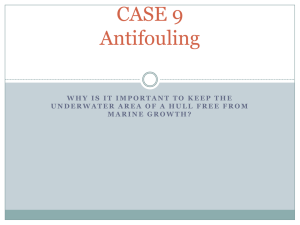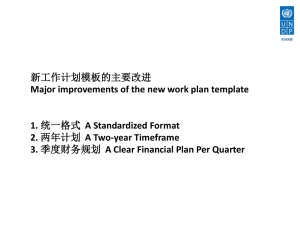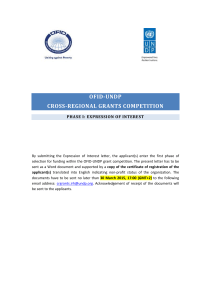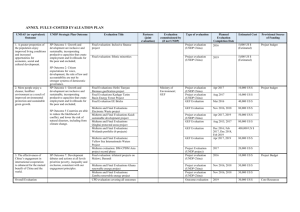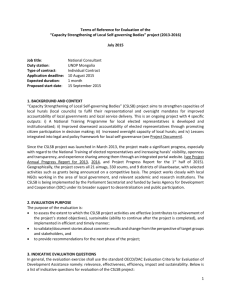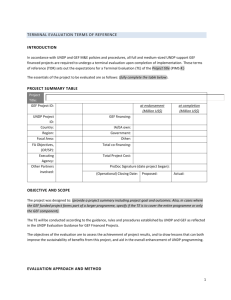TE-AFP-TOR-draft-international
advertisement
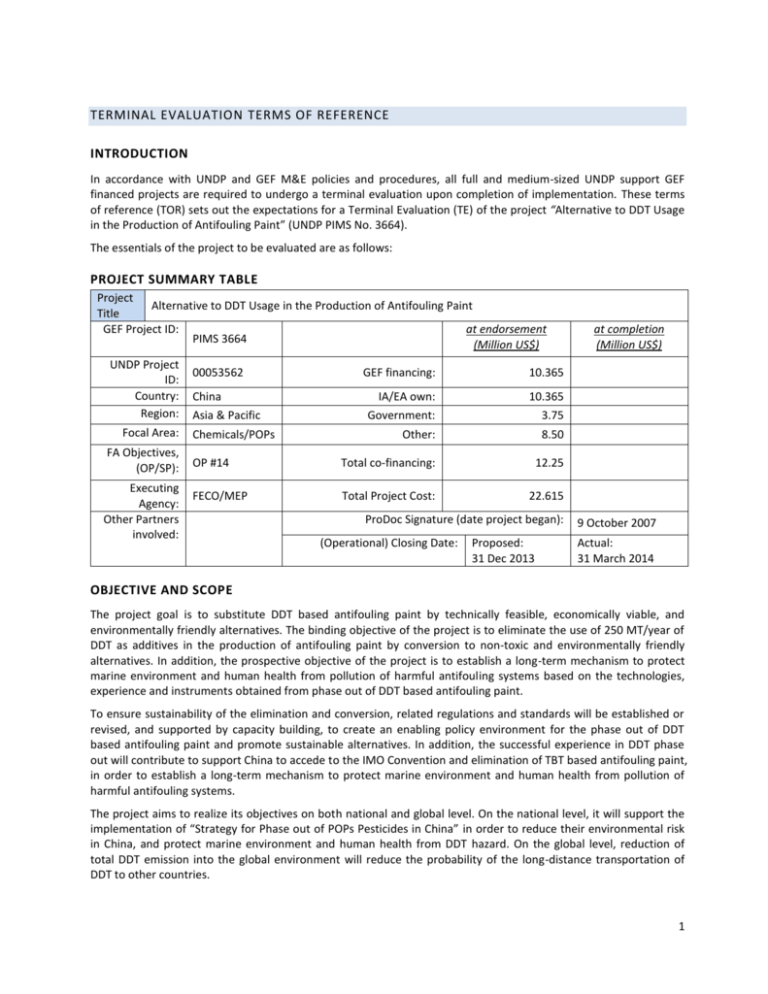
TERMINAL EVALUATION TERMS OF REFERENCE INTRODUCTION In accordance with UNDP and GEF M&E policies and procedures, all full and medium-sized UNDP support GEF financed projects are required to undergo a terminal evaluation upon completion of implementation. These terms of reference (TOR) sets out the expectations for a Terminal Evaluation (TE) of the project “Alternative to DDT Usage in the Production of Antifouling Paint” (UNDP PIMS No. 3664). The essentials of the project to be evaluated are as follows: PROJECT SUMMARY TABLE Project Alternative to DDT Usage in the Production of Antifouling Paint Title GEF Project ID: at endorsement PIMS 3664 (Million US$) UNDP Project ID: Country: Region: Focal Area: FA Objectives, (OP/SP): Executing Agency: Other Partners involved: 00053562 GEF financing: 10.365 IA/EA own: Government: 10.365 3.75 Other: 8.50 OP #14 Total co-financing: 12.25 FECO/MEP Total Project Cost: 22.615 China Asia & Pacific Chemicals/POPs ProDoc Signature (date project began): (Operational) Closing Date: Proposed: 31 Dec 2013 at completion (Million US$) 9 October 2007 Actual: 31 March 2014 OBJECTIVE AND SCOPE The project goal is to substitute DDT based antifouling paint by technically feasible, economically viable, and environmentally friendly alternatives. The binding objective of the project is to eliminate the use of 250 MT/year of DDT as additives in the production of antifouling paint by conversion to non-toxic and environmentally friendly alternatives. In addition, the prospective objective of the project is to establish a long-term mechanism to protect marine environment and human health from pollution of harmful antifouling systems based on the technologies, experience and instruments obtained from phase out of DDT based antifouling paint. To ensure sustainability of the elimination and conversion, related regulations and standards will be established or revised, and supported by capacity building, to create an enabling policy environment for the phase out of DDT based antifouling paint and promote sustainable alternatives. In addition, the successful experience in DDT phase out will contribute to support China to accede to the IMO Convention and elimination of TBT based antifouling paint, in order to establish a long-term mechanism to protect marine environment and human health from pollution of harmful antifouling systems. The project aims to realize its objectives on both national and global level. On the national level, it will support the implementation of “Strategy for Phase out of POPs Pesticides in China” in order to reduce their environmental risk in China, and protect marine environment and human health from DDT hazard. On the global level, reduction of total DDT emission into the global environment will reduce the probability of the long-distance transportation of DDT to other countries. 1 The project results and resources framework consists of six components, with anticipated outputs specified for each component: Institutions and mechanism for project management and coordination Management information system (MIS) and information management Enabling policy environment Conversion from DDT based antifouling paints to alternatives Environmental education and awareness raising Monitoring and evaluation The TE will be conducted according to the guidance, rules and procedures established by UNDP and GEF as reflected in the UNDP Evaluation Guidance for GEF Financed Projects. The objectives of the evaluation are to assess the achievement of project results, and to draw lessons that can both improve the sustainability of benefits from this project, and aid in the overall enhancement of UNDP programming. EVALUATION APPROACH AND METHOD An overall approach and method1 for conducting project terminal evaluations of UNDP supported GEF financed projects have developed over time. The evaluator is expected to frame the evaluation effort using the criteria of relevance, effectiveness, efficiency, sustainability, and impact, as defined and explained in the UNDP Guidance for Conducting Terminal Evaluations of UNDP-supported, GEF-financed Projects. A set of questions covering each of these criteria have been drafted and are included with this TOR (Annex C). The evaluator is expected to amend, complete and submit this matrix as part of an evaluation inception report, and shall include it as an annex to the final report. The evaluation must provide evidence‐based information that is credible, reliable and useful. The evaluator is expected to follow a participatory and consultative approach ensuring close engagement with government counterparts, in particular the GEF operational focal point, UNDP Country Office, project team, UNDP GEF Technical Adviser based in the region and key stakeholders. The evaluator is expected to conduct a field mission to Beijing, and project sites in Guangdong, Zhejiang, Shanghai and Shandong Provinces. Interviews will be held with the following organizations and individuals at a minimum with the Ministry of Finance, three Local Project Management Offices (PMOs) at Zhejiang, Guangdong and Shandong Provinces, including provincial Environmental Protection Bureaus (EPBs), and research institutions involved in the project activities, etc. The evaluator will review all relevant sources of information, such as the project document, project reports – including Annual APR/PIR, project budget revisions, midterm review, progress reports, GEF focal area tracking tools, project files, national strategic and legal documents, and any other materials that the evaluator considers useful for this evidence-based assessment. A list of documents that the project team will provide to the evaluator for review is included in Annex B of this Terms of Reference. EVALUATION CRITERIA & RATINGS An assessment of project performance will be carried out, based against expectations set out in the Project Logical Framework/Results Framework (see Annex A), which provides performance and impact indicators for project implementation along with their corresponding means of verification . The evaluation will at a minimum cover the criteria of: relevance, effectiveness, efficiency, sustainability and impact. Ratings must be provided on the following performance criteria. The completed table must be included in the evaluation executive summary. The obligatory rating scales are included in Annex D. 1 For additional information on methods, see the Handbook on Planning, Monitoring and Evaluating for Development Results, Chapter 7, pg. 163 2 Evaluation Ratings: 1. Monitoring and Evaluation M&E design at entry M&E Plan Implementation Overall quality of M&E 3. Assessment of Outcomes Relevance Effectiveness Efficiency Overall Project Outcome Rating rating rating 2. IA& EA Execution Quality of UNDP Implementation Quality of Execution - Executing Agency Overall quality of Implementation / Execution 4. Sustainability Financial resources: Socio-political: Institutional framework and governance: Environmental : Overall likelihood of sustainability: rating rating PROJECT FINANCE / COFINANCE The Evaluation will assess the key financial aspects of the project, including the extent of co-financing planned and realized. Project cost and funding data will be required, including annual expenditures. Variances between planned and actual expenditures will need to be assessed and explained. Results from recent financial audits, as available, should be taken into consideration. The evaluator(s) will receive assistance from the Country Office (CO) and Project Team to obtain financial data in order to complete the co-financing table below, which will be included in the terminal evaluation report. Co-financing (type/source) UNDP own financing (mill. US$) Planned Actual Government (mill. US$) Planned Actual Partner Agency (mill. US$) Planned Actual Total (mill. US$) Actual Actual Grants Loans/Concessions In-kind support Other Totals MAINSTREAMING UNDP supported GEF financed projects are key components in UNDP country programming, as well as regional and global programmes. The evaluation will assess the extent to which the project was successfully mainstreamed with other UNDP priorities, including poverty alleviation, improved governance, the prevention and recovery from natural disasters, and gender. IMPACT The evaluators will assess the extent to which the project is achieving impacts or progressing towards the achievement of impacts. Key findings that should be brought out in the evaluations include whether the project has demonstrated: a) verifiable improvements in ecological status, b) verifiable reductions in stress on ecological systems, and/or c) demonstrated progress towards these impact achievements.2 CONCLUSIONS, RECOMMENDATIONS & LESSONS The evaluation report must include a chapter providing a set of conclusions, recommendations and lessons. 2 A useful tool for gauging progress to impact is the Review of Outcomes to Impacts (ROtI) method developed by the GEF Evaluation Office: ROTI Handbook 2009 3 IMPLEMENTATION ARRANGEMENTS The principal responsibility for managing this evaluation resides with the UNDP CO in Beijing, People’s Republic of China. The UNDP CO will contract the evaluators and ensure the timely provision of per diems and travel arrangements within the country for the evaluation team. The Project Team will be responsible for liaising with the Evaluators team to set up stakeholder interviews, arrange field visits, coordinate with the Government etc. EVALUATION TIMEFRAME The total duration of the evaluation will be 30 days according to the following plan: Activity Timing Preparation Evaluation Mission Draft Evaluation Report Final Report 3 days (recommended: 2-4) 15 days (r: 7-15) 10 days (r: 5-10) 2 days (r: 1-2) Completion Date April 21-23, 2014 April 28- May 16, 2014 May 19-Jun 6, 2014 June 27, 2014 EVALUATION DELIVERABLES The evaluation team is expected to deliver the following: Deliverable Content Timing Responsibilities Inception Report Evaluator provides clarifications on timing and method No later than 2 weeks before the evaluation mission. Evaluator submits to UNDP CO Presentation Initial Findings End of evaluation mission To project management, UNDP CO Draft Final Report Full report, (per annexed template) with annexes Within 3 weeks of the evaluation mission Sent to CO, reviewed by RTA, PCU, GEF OFPs Final Report* Revised report Within 1 week of receiving UNDP comments on draft Sent to CO for uploading to UNDP ERC. *When submitting the final evaluation report, the evaluator is required also to provide an 'audit trail', detailing how all received comments have (and have not) been addressed in the final evaluation report. TEAM COMPOSITION The evaluation team will be composed of 1 international evaluator and 1 national evaluator. The consultants shall have prior experience in evaluating similar projects. Experience with GEF financed projects is an advantage. The international evaluator will be the team leader and responsible for finalizing the report. The evaluators selected should not have participated in the project preparation and/or implementation and should not have conflict of interest with project related activities. The Team members must present the following qualifications: Minimum 10 years of relevant professional experience Knowledge and UNDP and GEF Previous experience with results‐based monitoring and evaluation methodologies; Technical knowledge in the POPs and Chemical areas Previous experience of UNDP/GEF programme evaluation is asset 4 EVALUATOR ETHICS Evaluation consultants will be held to the highest ethical standards and are required to sign a Code of Conduct (Annex E) upon acceptance of the assignment. UNDP evaluations are conducted in accordance with the principles outlined in the UNEG 'Ethical Guidelines for Evaluations' PAYMENT MODALITIES AND SPECIFICATIONS The payment will be in a lump sum covering the consulting fee of 30 working days and the travel cost (transportation, DSA and terminal allowances) for international travel. Transportation costs for local sites visits will be arranged and paid by UNDP. % 28.6% 71.4% Milestone After contract signed (advance of total travel cost) Following submission and approval (UNDP-CO and UNDP RTA) of the final terminal evaluation report (consulting fee for 30 working days) APPLICATION PROCESS Applicants are requested to apply online (http://cn.undp.org) by March 31, 2014. Individual consultants are invited to submit applications together with their CV for these positions. The application should contain a current and complete C.V and an updated P11 UNDP Personal History Form (for Service Contracts and Individual Contracts) in English with indication of the e‐mail and phone contact. Shortlisted candidates will be requested to submit a price offer indicating the total cost of the assignment (including daily fee, per diem and travel costs). UNDP applies a fair and transparent selection process that will take into account the competencies/skills of the applicants as well as their financial proposals. Qualified women and members of social minorities are encouraged to apply. 5 ANNEX A: PROJECT LOGICAL FRAMEWORK Project Strategy Objectively verifiable indicators Goal DDT based antifouling paint is to be substituted by technically feasible, economically viable, and environmentally friendly alternatives so as to help China fulfill the obligations under Stockholm Convention to control the use of DDT and protect the environment and human health. Objectively Verifiable Indicators Objective Binding objective: Use of 250 MT DDT per year in the production of DDT based antifouling paints will be stopped. Prospective objective: A longterm mechanism is to be established to protect the marine environment from pollution of harmful antifouling systems by supporting China to sign International Convention on the Control of Harmful Antifouling Systems on Ships (the IMO Convention), based on the technologies, experience and instruments gained from the phase out of DDT based antifouling paint. Outcome 1 Institutions and mechanism for project management and coordination Activity 1 Establish Annual production of 250 MT DDT used as additives will be reduced at Tianjin Chemical Plant. Zero DDT should be detected in antifouling paint. Residual or enrichment of DDT in the marine environmental media and sea organisms will be found to decrease. Alternatives which are technically feasible, economically competitive, and environmentally friendly will be developed, produced and distributed. Sources of Verification Tender documents to request for proposals of procurement of technical service and capital equipment. TORs for recruiting consulting services. Work plans. Revised or newly promulgated laws, regulations and standards. Thematic study reports. M & E reports. Assumptions and Risks Phase out and substitution actions will be supported by the nation, society and sector. Barriers can be effectively removed with necessary support of the project. Alternatives production can become financially sustainable after the completion of the project. Implementation and enforcement of policy and management mechanisms can continue to work effectively after the completion of the project. Barriers to commercialize the alternatives will be removed. Laws, regulations and standards will be revised or established. Experience in phasing out DDT antifouling paint will be replicated to phase out organotin based antifouling paints. Concentration of organotin in the marine media will be reduced. A cross sectoral Steering Committee will be established at the national and local levels. A cross sectoral project team will be established at the national level for daily project management and coordination. Name list of Steering Committee. Agendas and minutes of Steering Committee meetings. Name list of the national project team, responsibility defined and work Smooth coordination and sound cooperation can be achieved among sectors and between central and local levels. Various stakeholders can reach 6 project management institutions and build operational capacity. 3 local Project Management Offices (PMOs) will be established drawing upon resources from related departments. Act. 1.1 Establish project management institutions and coordination mechanisms. CTA, NTA and other consultants recruited. Act. 1.2 Establish a national expert team to provide technical and consulting supports to project implementation. Act. 1.3 Conduct trainings to improve managerial and technical capabilities for project implementation. Act. 1.4 abroad. Materials for technical and management training will be compiled. consensus and recognition of the project objectives and activities. Name list of the local PMOs, responsibility defined, work plan finalized and work reports. Qualified CTA, NTA and other consultants can be recruited and fielded in time. TORs for CTA, NTA and other consultants. Trainees can be well organized and mobilized. Training materials for technical and management training. Work plan for study tour abroad. Countries with advanced technologies and experience are cooperative to host the study tour and share information. An on-line operational project MIS. The needed data can be made available. An on-line operational project website. The hardware and software configuration of the MIS for Sino-Italian Cooperation Project on Pesticidal POPs can be extended to accommodate the MIS for this project. Plan for study tour abroad will be developed and mission report will be drafted and share to build capacity. Conduct study tour Outcome 2 Managemen t information system (MIS) and information management Activity 2 Establish an MIS and website for the project Act. 2.1 Government research agencies or private consulting firms will be selected to provide technical and consulting services. reports. Establish an MIS. Act. 2.2 Establish a mechanism for effective information transmission and sharing. Act. 2.3 Establish a website to disseminate project information to the public. A comprehensive evaluation will be conducted on the management information systems of the departments of fishing boat inspection, commercial ship inspection, and hazardous chemicals management, and marine environment management. Documentation series for MIS development. Needs of data and information, software and hardware to implement this project will be assessed. Data exchange protocol will be developed to support information collection, processing and transmission among sectors and between central and local PMOs. Database and base model will be developed to collect and process technical, socioeconomic, and environmental data in MIS. A project website will be developed, maintained and promoted. 7 Outcome 3 Enabling policy environment Activity 3 Establish or revise regulations, standards, and action plan supported by capacity building to create an enabling policy environment for phase out of DDT based antifouling paint and promotion of sustainable alternatives. Act. 3.1 Establish or revise related regulations, standards, and rules. Act. 3.2 Revise compulsory rules of inspection of ship products Act. 3.3 Establish and promote a voluntary certification and labeling program in the antifouling paint sector. General Specification for Antifouling Paint on Ship Bottom will be revised taking into account environmental indicators. Method to Detect DDT Content in Antifouling Paint and Paint Film will be developed. Regulation to Ban DDT Usage for Antifouling Production Paint and Prohibit Ships to Use DDT Based Antifouling Paint will be drafted and made into effect. Rule for Inspection of Ship Products and Rule for Inspection of Fishing Boat Products will be revised. Rule for Voluntary Certification and Labeling of Antifouling Paints will be developed. Dossier for China to accede to the IMO Convention will be prepared. Action Plan for China to Implement the IMO Convention will be developed. Revised General Specification for Antifouling Paint on Ship Bottom. Method to Detect DDT Content in Antifouling Paint and Paint Film. Regulation to Ban DDT Usage for Antifouling Production Paint and Prohibit Ships to Use DDT Based Antifouling Paint. Rule for Inspection of Ship Products and Rule for Inspection of Fishing Boat Products. Regulations, standards, and policies can be approved and made into effects by related administrative departments. Voluntary certification and labeling program can exert complementary functions with compulsory inspection rules to promote the alternatives. Active cooperation and smooth coordination can be achieved among different departments. A Voluntary Certification and Labeling Program for Antifouling Paints. Dossier for China to accede to the IMO Convention. Action Plan for China to Implement the IMO Convention. Capacity of various departments will be strengthened. Act. 3.4 Sustain DDT phase out by reducing the potential risk of TBT use in antifouling paint. Act. 3.5 Strengthen capacity of related departments to effectively implement and enforce regulations and standards. Outcome 4 Conversion from DDT based antifouling paints to alternatives. R & D institutes able to synthesize alternative biocides, active chilly ingredients, or other environmentally friendly antifoulants that will Dossier of request for proposal and bidding proposals. Technologies for synthesizing Results from applied research can be completed on time to be used by the project. 8 Activity 4 Adopt multiple means of technological support, policy induction, market regulation, and awareness raising and education to promote the conversion from DDT/TBT based antifouling paints to alternatives. Act. 4.1 Test, select and acquire alternative technologies. Act. 4.2 Select demonstration enterprises. Act. 4.3 Produce, distribute and promote alternatives. Act. 4.4 Conduct environmental sound management of DDT at contaminated sites and on equipment. be selected. Applied researches will be conducted to promote the maturity of the alternative technologies for use by the project. On-ship coating experiment and scale-up production experiment will be conducted. Alternatives will prove to be technically feasible, environmentally friendly and can be produced at scale of economy. Antifouling paint manufacturers having strong technical and managerial competence and sound business plan will be selected. Feasibility study and EIA will be conducted according to related construction project approval procedures in China. Full scale production of alternatives will be started. Handbook to apply alternatives will be compiled and distributed. alternative biocides, active chilly ingredients, or other environmentally friendly antifoulants. Technologies for full scale production of alternative antifouling paints. Feasibility study reports and EIA reports. Approval documents from Government Certificates and labels granted to enterprises. Enterprise records of production and sale. Handbooks to apply alternatives. Feasibility study reports on disposal of DDT based antifouling paint equipment and part of DDT production equipment. Issues of intellectual property rights can be effectively addressed in time for existing alternative technologies or products that can be promoted by this project. Application and EIA reports for alternative production projects can be approved by authorities. Active cooperation among enterprises, dealers and users can be achieved. Alternative production industry can be commercialized after the completion of the project. Medium and small sized enterprises can be well supported and guided to produce alternatives and provide distribution and after-sale services. Incentives will be provided to mass production and purchase. Part of DDT production equipment will be closed and disposed at Tianjin Chemical Plant. Outcome 5 Environment al education and awareness raising Publicity materials for TV and film media for marine environmental protection and antifouling systems will be made. Publicity materials of DDT/TBT based antifouling paints and marine environmental protection. Good quality publicity materials of various forms and targeting various audiences can be produced in time. Activity 5 Conduct environmental education to promote the environmental awareness of the key stakeholders and the public, improve their understanding of the harm of DDT/TBT based antifouling paints and the benefits of alternatives. Special programs will be made on local radio stations. News reported on media. Active public participation. A special column will be arranged in a professional journal. Contents introducing marine antifouling system will be added to the textbook for environmental education in local middle and primary schools. Materials for training of administrative staff of local government agencies. Materials for training of NGOs in universities and civil society. Focal points of the communities. Contents in middle and primary 9 Act. 5.1 Prepare publicity materials for environmental education and awareness raising purpose targeting government officials, personnel in the industrial field and the public through multiple media of TV, radio, newspaper, magazine, journal, Internet, CD-ROM, and printing materials. The project website will be regularly updated. Act. 5.2 Mobilize NGOs to conduct community based environmental education and awareness raising. NGOs, universities and civil society will be mobilized to popularize knowledge about antifouling paints and raise their environmental awareness in community level. 2 press conferences will be held for milestone events. school textbooks introducing antifouling paints and marine environmental protection. Nation wide traveling exhibition will be launched to disseminate the project results. Articles in special column of professional journal. A fund raising activity will be organized for deformed children suffering from toxic antifouling paints. Plan for joint exhibition with local marine exhibition halls. Work plan for nation wide exhibition. Joint exhibitions will be held with local marine exhibition halls. Focal points in communities and fishermen organizations will be established for long-term alternative promotion and environmental awareness raising. Environmental education will be conducted systematically in local middle and primary schools. Training materials will be compiled and training workshops held for the local administrative staff from departments of economic trade, fishery, navigation, and environmental protection. Outcome 6 Monitoring and evaluation Activity 6 Effective monitoring and evaluation on project implementation and achieved results Act. 6.1 Conduct regular meetings to review progress and project result review. Inception meeting, annual steering committee meetings, annual project review meetings and tripartite project review meetings will be held. Special inspections on enforcement of regulations, rules, and standards will be launched. Meeting minutes or memorandum. Annual project reviews. Final project review. Reports of independent project evaluation. Materials for monitoring and evaluation can be provided sufficiently in advance of the actual inspections, investigations, and various review meetings. Independent mid-term and final project evaluations will be held. The related staff at national and local levels for implementing the project can be available for making presentations assisting field investigations. Memorandum or minutes of meeting for each There is open, transparent, and effective 10 Act. 6.2 Launch field investigations and inspections to monitor and evaluate progress of project implementation. field mission, annual progress and experience review reports, and the final project result and experience review reports will be prepared. communication between the M & E staff and the project implementation staff. Act. 6.3 Prepare progress reports for measurement of Means of Verification to monitor project purpose indicators, project progress and performance. Act. 6.4 Conduct annual project audit. 11 ANNEX B: LIST OF DOCUMENTS TO BE REVIEWED BY THE EVALUATORS I. Project Documents UNDP ProDoc signed with China MEP GEF Project Information Form (PIF), Project Document and Log Frame Analysis (LFA) Project Implementation Plan Implementing/executing partner arrangements List and contact details for project staff, key project stakeholders, including Project Boards, and other partners to be consulted Project sites, highlighting suggested visits Midterm evaluation (MTE) and other relevant evaluations and assessments Annual Project Implementation Reports (PIR) Project budget, broken out by outcomes and outputs Project Tracking Tool Financial Data Sample of project communications materials, i.e. press releases, brochures, documentaries, etc. II. UNDP Documents Development Assistance Framework (UNDAF) Country Programme Document (CPD) Country Programme Action Plan (CPAP) III. GEF Documents GEF focal area strategic program objectives 12 ANNEX C: EVALUATION QUESTIONS Evaluative Criteria Questions Indicators Sources Methodology Relevance: How does the project relate to the main objectives of the GEF focal area, and to the environment and development priorities at the local, regional and national levels? How does the Project support the objectives of the Stockholm Convention (SC) How does the Project support the related strategic priorities of the GEF? How does the Project support the development objectives of People’s Republic of China? Does the Project adequately take into account the national realities, both in terms of institutional framework and programming, in its design and its implementation? To what extent were national partners involved in the design and implementation of the Project? Were the capacities of executing institutions and counterparts properly considered when the project was designed? Existence of a clear relationship between Project documents Document analysis project objectives and GEF POPs focal area GEF focal area strategies GEF website and documents Interview with government, Project Team, UNDP and other project partners Degree of coherence between project objectives and national development priorities, policies and strategies Project documents Level of involvement of government officials and other partners in project design and implementation Key project partners China POPs National Implementation Plan Document analyses Interview with government officials and project partners Coherence between needs expressed by national stakeholders and UNDP-GEF criteria Does the Project participate in the implementation of the SC in China? How country-driven is the Project? How does the Project support the objectives of UNDP in this sector? Consistency between project objectives and UNDP strategies and development objectives Project document UNDP strategies and programme Document analyses Interviews with government, UNDP, other partners 13 How does the Project support the needs of target beneficiaries? Is the implementation of the Project been inclusive of all relevant Stakeholders? Are local beneficiaries and stakeholders adequately involved in Project design and implementation? Are there logical linkage between expected results of the project (log frame) and the project design (in terms of Project components, choice of partners, structure, delivery mechanism, scope, budget, use of resources etc.)? Is the length of the project sufficient to achieve project outcomes? Strength of the link between expected project results from the project and the needs of relevant stakeholders Degree of involvement and inclusiveness of stakeholders and beneficiaries in project design and implementation Level of coherence between expected project results and project design internal logic Level of coherence between project design and implementation approach Project partners and stakeholders Needs assessment studies Document analysis Interviews with relevant stakeholders Project documents Program and project documents Key project stakeholders Document analysis Key interviews Effectiveness: To what extent have the expected outcomes and objectives of the project been achieved? Has the project been effective in achieving its expected outcomes? o Institutions and mechanism for project management and coordination; o Management information system (MIS) and information management; o Enabling policy environment; o Conversion from DDT-based antifouling paints to alternatives; o Environmental education and awareness raising; o Monitoring and evaluation. What lessons have been learned from the project regarding achievement of outcomes? Indicators in project document results framework and logframe Project documents Document analysis Project Team and relevant stakeholders Interviews with Project Team Data reported in project Interviews with annual and quarterly relevant reports stakeholders Data collected through evaluation Data analysis Project documents and evaluations Document analysis What changes could have been made (if any) to the design of the project in order to improve the achievement of the project’s expected results? Efficiency: Was the project implemented efficiently, in-line with international and national norms and standards? Was adaptive management used or needed to ensure efficient resource use? Availability and quality of financial and progress reports Did the project logical framework and work plans and any changes made to them use as management tools during implementation Timeliness and adequacy of reporting UNDP Key interviews 14 Were the accounting and financial systems in place adequate for project management and producing accurate and timely financial information? Were progress reports produced accurately, timely and responded to reporting requirements including adaptive management change? Did the leveraging of funds (co-financing) happen as planned? Was procurement carried out in a manner making efficient use of project resources? To what extent partnerships/linkages between institutions / organizations were encourage and supported What partnerships/linkages were facilitated? Which ones can be considered sustainable? What was the level of efficiency of cooperation and collaboration arrangements? Did the project take into account local capacity in design and implementation of the project? provided Planned vs. actual funds leveraged Occurrence of change in project design / implementation approach (i.e. restructuring when needed to improve project efficiency) Specific activities conducted to support the development of cooperative arrangements between partners Examples of supported partnership? Project documents and evaluations Project partners and relevant stakeholders Document analysis Interviews Evidence that particular partnership/linkages will be sustained Types/quality of partnership cooperation methods utilized National expertise utilized Was there an effective collaboration between institutions responsible for implementing the project? Number/quality of analysis done to asses local capacity potential and absorptive capacity What lessons can be learned from the project regarding efficiency? How could the project have more efficiently carried out implementation (in terms of arrangement structures and procedures, partnership arrangements etc.)? Project Team Project documents and evaluations UNDP Document analysis Interviews Beneficiaries Data collected throughout evaluation Data analysis What change could have been made (if any) to the project in order to improve its efficiency)? How and to what extent have project implementation process, coordination with participating stakeholders and important aspects affected the timely project start-up, implementation and closure? Relationship and coordination mechanism Project documents of project partners Project Team and Timeliness of project activities relevant stakeholders implemented Document analysis Key interviews 15 Do the outcomes developed during the project formulation still represent the best project strategy for achieving the project objectives? Does the project consult and make use of skills, experience and knowledge of the appropriate government entities, NGOs, community groups, private sector, local governments and academic institutions in the implementation and evaluation of project activities? Extent of relevance of project outcomes and objectives to changing circumstances Project documents Document analysis Project Team and relevant stakeholders Key interviews National capacities utilized Project documents Document analysis Number/type of partnership formed Project Team and relevant stakeholders Key interviews Sustainability: To what extent are there financial, institutional, social-economic, and/or environmental risks to sustaining long-term project results? Evidence/quality of sustainability strategy Was project sustainability strategy developed during the project design? How relevant was the project sustainability strategy? Project documents Evidence/quality of steps taken to address Project Team and sustainability relevant stakeholders Document analysis Key interviews Beneficiaries Are there any financial risks that may jeopardize sustenance of project Financial resources available after project Project Team and outcomes? What is the likelihood of financial and economic resources not completion to support and sustain project relevant stakeholders being available once the GEF assistance ends (resources can be from multiple outcomes Project partners sources, such as the public and private sectors, income generating activities, Beneficiaries and trends that may indicate that it is likely that in future there will be adequate financial resources for sustaining project’s outcomes)? Document and data analysis Are there any social or political risks that may jeopardize sustenance of Social and political risk assessment data to Project Team and project outcomes? What is the risk that the level of stakeholder ownership support sustainability of project outcomes relevant stakeholders will be insufficient to allow for the project outcomes/benefits be sustained? Project partners Do the various key stakeholders see that it is in their interest that the project Beneficiaries benefits continue to flow? Is there a sufficient public/ stakeholder awareness in support of the long term objectives of the project? Document and data analysis Key interviews Key interviews Impact: Are there indications that the project has contributed to, or enabled progress toward, reduced environmental stress and/or improved ecological status? What are the main positive and negative impacts of the project? Project impacts (e.g. capacity, policy enabling framework, etc.) Project documents Document analysis GEF focal area tracking tools Key Interviews 16 How has the project contributed to global environmental benefits or reductions in stress to ecological systems, or is there evidence that the project has put in place processes that will lead to such impact? Levels of reduction of POPs release Project documents Document analysis Systems, structures and capacities that contribute to changes in POPs release GEF focal area tracking tools Key Interviews 17 ANNEX D: RATING SCALES Ratings for Outcomes, Effectiveness, Efficiency, M&E, I&E Execution 6: Highly Satisfactory (HS): no shortcomings 5: Satisfactory (S): minor shortcomings 4: Moderately Satisfactory (MS) 3. Moderately Unsatisfactory (MU): significant shortcomings 2. Unsatisfactory (U): major problems 1. Highly Unsatisfactory (HU): severe problems Sustainability ratings: Relevance ratings 4. Likely (L): negligible risks to sustainability 3. Moderately Likely (ML):moderate risks 2. Relevant (R) 1.. Not relevant (NR) 2. Moderately Unlikely (MU): significant risks 1. Unlikely (U): severe risks Impact Ratings: 3. Significant (S) 2. Minimal (M) 1. Negligible (N) Additional ratings where relevant: Not Applicable (N/A) Unable to Assess (U/A 18 ANNEX E: EVALUATION CONSULTANT CODE OF CONDUCT AND AGREEMENT FORM Evaluators: 1. 2. 3. 4. 5. 6. 7. Must present information that is complete and fair in its assessment of strengths and weaknesses so that decisions or actions taken are well founded. Must disclose the full set of evaluation findings along with information on their limitations and have this accessible to all affected by the evaluation with expressed legal rights to receive results. Should protect the anonymity and confidentiality of individual informants. They should provide maximum notice, minimize demands on time, and respect people’s right not to engage. Evaluators must respect people’s right to provide information in confidence, and must ensure that sensitive information cannot be traced to its source. Evaluators are not expected to evaluate individuals, and must balance an evaluation of management functions with this general principle. Sometimes uncover evidence of wrongdoing while conducting evaluations. Such cases must be reported discreetly to the appropriate investigative body. Evaluators should consult with other relevant oversight entities when there is any doubt about if and how issues should be reported. Should be sensitive to beliefs, manners and customs and act with integrity and honesty in their relations with all stakeholders. In line with the UN Universal Declaration of Human Rights, evaluators must be sensitive to and address issues of discrimination and gender equality. They should avoid offending the dignity and self-respect of those persons with whom they come in contact in the course of the evaluation. Knowing that evaluation might negatively affect the interests of some stakeholders, evaluators should conduct the evaluation and communicate its purpose and results in a way that clearly respects the stakeholders’ dignity and self-worth. Are responsible for their performance and their product(s). They are responsible for the clear, accurate and fair written and/or oral presentation of study imitations, findings and recommendations. Should reflect sound accounting procedures and be prudent in using the resources of the evaluation. Evaluation Consultant Agreement Form3 Agreement to abide by the Code of Conduct for Evaluation in the UN System Name of Consultant: __ _________________________________________________ Name of Consultancy Organization (where relevant): ________________________ I confirm that I have received and understood and will abide by the United Nations Code of Conduct for Evaluation. Signed at place on date Signature: ________________________________________ 3www.unevaluation.org/unegcodeofconduct 19 ANNEX F: EVALUATION REPORT OUTLINE 4 i. ii. iii. 1. 2. 3. 3.1 3.2 4The Opening page: Title of UNDP supported GEF financed project UNDP and GEF project ID#s. Evaluation time frame and date of evaluation report Region and countries included in the project GEF Operational Program/Strategic Program Implementing Partner and other project partners Evaluation team members Acknowledgements Executive Summary Project Summary Table Project Description (brief) Evaluation Rating Table Summary of conclusions, recommendations and lessons Acronyms and Abbreviations (See: UNDP Editorial Manual5) Introduction Purpose of the evaluation Scope & Methodology Structure of the evaluation report Project description and development context Project start and duration Problems that the project sought to address Immediate and development objectives of the project Baseline Indicators established Main stakeholders Expected Results Findings (In addition to a descriptive assessment, all criteria marked with (*) must be rated 6) Project Design / Formulation Analysis of LFA/Results Framework (Project logic /strategy; Indicators) Assumptions and Risks Lessons from other relevant projects (e.g., same focal area) incorporated into project design Planned stakeholder participation Replication approach UNDP comparative advantage Linkages between project and other interventions within the sector Management arrangements Project Implementation Adaptive management (changes to the project design and project outputs during implementation) Partnership arrangements (with relevant stakeholders involved in the country/region) Report length should not exceed 40 pages in total (not including annexes). 5 UNDP Style Manual, Office of Communications, Partnerships Bureau, updated November 2008 6 Using a six-point rating scale: 6: Highly Satisfactory, 5: Satisfactory, 4: Marginally Satisfactory, 3: Marginally Unsatisfactory, 2: Unsatisfactory and 1: Highly Unsatisfactory, see section 3.5, page 37 for ratings explanations. 20 3.3 4. 5. Feedback from M&E activities used for adaptive management Project Finance: Monitoring and evaluation: design at entry and implementation (*) UNDP and Implementing Partner implementation / execution (*) coordination, and operational issues Project Results Overall results (attainment of objectives) (*) Relevance(*) Effectiveness & Efficiency (*) Country ownership Mainstreaming Sustainability (*) Impact Conclusions, Recommendations & Lessons Corrective actions for the design, implementation, monitoring and evaluation of the project Actions to follow up or reinforce initial benefits from the project Proposals for future directions underlining main objectives Best and worst practices in addressing issues relating to relevance, performance and success Annexes ToR Itinerary List of persons interviewed Summary of field visits List of documents reviewed Evaluation Question Matrix Questionnaire used and summary of results Evaluation Consultant Agreement Form 21 ANNEX G: EVALUATION REPORT CLEARANCE FORM (to be completed by CO and UNDP GEF Technical Adviser based in the region and included in the final document) Evaluation Report Reviewed and Cleared by UNDP Country Office Name: ___________________________________________________ Signature: ______________________________ Date: _________________________________ UNDP GEF RTA Name: ___________________________________________________ Signature: ______________________________ Date: _________________________________ 22
